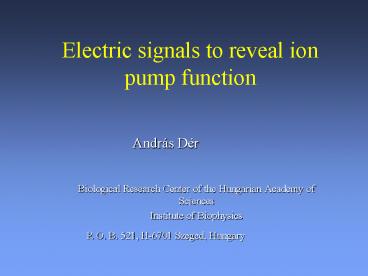Electric signals to reveal ion pump function PowerPoint PPT Presentation
1 / 26
Title: Electric signals to reveal ion pump function
1
Electric signals to reveal ion pump function
András Dér
- Biological Research Center of the Hungarian
Academy of Sciences - Institute of Biophysics
P. O. B. 521, H-6701 Szeged, Hungary
2
Electric signals
Crucial role in life functions
Signal and energy transduction
3
Signal transduction
Propagation of the nerve impulse
Hodgkin, Huxley, Katz
Nobel prize (1963)
4
Energy transduction
mitochondrial electron transfer
chemiosmosis P. Mitchell, Nobel prize, 1978
ATP-ase Boyer, Walker, Skou, Nobel prize, 1997
5
Why should we measure electric signals?
Direct information about kinetics, ion
specificity Together with other methods details
of the molecular mechanism is expected to be
revealed Physicist's approach atomic level
description - chance to design molecules for
biotechnology
6
How to measure electric signals?
Patch clamp Nobel prize 1991 Neher and Sackmann
Alternative methods. Prerequisite electrically
asymmetric sample
7
1. Surface methods
BLM method (Dancsházy et al., 1976 Bamberg et
al., 1980) SSM method (Fendler et al., 1992)
Advantage ion specificity Disadvantage limited
spatio-temporal information
8
2. Bulk methods
Suspension method (Keszthelyi and Ormos,
1980) Gel method (Dér et
al., 1985) Dried samples (Nagy,
1978 Váró, 1983)
Advantageous for kinetic experiments
9
Bacteriorhodopsin
10
bR plays a model role among ion-transporting
membrane proteins
stability, absorption changes, photoelectric
effects
11
Gel method
12
Correlation between electric and optical signals
13
Conditions speed, linearity, insensitivity to
geometric details
14
Modeling the electrolyte
15
Ionic relaxation
16
Properties of ionic relaxation
1. speed 2. anisotropy (F) 3. linearity (E) 4.
insensitivity to geometric details (B,C,D)
17
Temporal superposition solved
18
How can we use this?
19
20
(No Transcript)
21
Detection of the 3D electric signals
Dér et al. (1999)
22
Testing MD models
Measurement
Model
23
(No Transcript)
24
The function of a bR molecule
25
Further application examples of the bulk methods
Cl- pumping (halorhodopsin, bacteriorhodopsin) Si
gnal transduction (Chlamydomonas rhodopsin,
squid rhodopsin) Primary processes of
photosynthesis (plant and bacterial
photosynthetic reaction centers) Bioelectronics -
fast photodiode, motion sensitive
camera (bacteriorhodospin)
26
Acknowledgements
Lajos Keszthelyi Pál Ormos György Váró Rudolf
Tóth-Boconádi László Oroszi László Fábián Szeged
Stefka Taneva Sofia Sándor Suhai Nicoleta
Bondar Heidelberg Walther Stoeckenius San
Francisco

